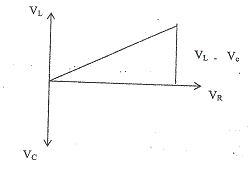In part (a), responses were generally poor, indicating that the teaching of the principles underlying the operations of these devices was most likely neglected in schools.
In part (b), not many candidates succeeded in recognizing that eddy currents are those that are induced in a conductor (plate/block) subjected to a varying magnetic field. Giving at least one valid additional information was also an uphill task to many. Performance in it was poor.
Part (c) was the most poorly attempted while performance in part (d) was satisfactory.
The expected answers are as follows:
(a) Differences between a d. c. generator and a moving coil galvanometer.
| D. C. generator |
moving coil galvanometer |
| converts mechanical energy to electrical energy |
converts electrical energy to mechanical energy. |
| uses split rings or commutator |
uses hair springs. |
| rotation of coil is continuous |
rotation of coil is incomplete |
| uses carbon brushes (as terminals) |
uses jeweled bearings (as terminals) |
(b) Eddy currents are currents induced in a conductor when subjected to
varying magnetic field.
Any valid additional information e.g.
- eddy current flows in a circular path or closed loops;
- eddy current generates heat;
- eddy current cannot flow through gaps or slots;
- The currents move in such a direction as to oppose the change producing them.
Devices in which eddy currents are applied
- pointers of sensitive electric meters
- sensitive mass balances
- brakes in large electric motors
- speedometers in automobiles
- detection of cracks in railway tracks
- detection of metals
(c) Principle on which a potentiometer is based
When a steady current is allowed to pass through a uniform wire, equal lengths of the wire will have equal potential differences.
OR
The p.d across a length of a wire is (directly) proportional to the length provided the wire has a uniform cross section.

Vector diagram showing
VL with arrow
VC with arrow
VR with arrow
V2 = VR2 + (VL - VC)2
1102 = 802 + (40 – Vc)2
1102 -802 = (40 – Vc)2
(40 – Vc ) =

(110 + 80) (110 – 80)
40 – VC = + 75.5
VC = 40 + 75.5
VC = 115.5V
(ii) VC = I X c
Xc = Vc / = 1 /
I 2π¦C 2
∴ C = I/2π¦VC = 2 x 3.14 x 60 x 115.5
C = 0.0000459 C = 45.9 x 10-6 F or 46mF



